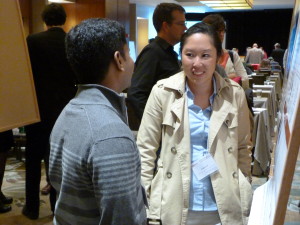
Report by Charis Himeda, PhD
The FSH Society’s 2015 International Research Consortium and Research Planning Meetings, held in Boston on October 5-6, 2015, brought together over 100 investigators, including leaders in FSHD research and many industry sponsors, to discuss advances made over the past year. In a striking change from previous years, the majority of research presented was translational.
The shift in focus to therapeutic development serves as an encouraging reminder that, in work by Richard Lemmers, PhD, Stephen Tapscott, MD PhD, Silvere van der Maarel, PhD, and their collaborators, the fundamental genetic lesions causing both forms of FSHD have been identified and characterized. This seminal accomplishment has paved the way for a multitude of new studies aimed at understanding the downstream pathways that lead to disease.
But dissecting these pathways is not a simple or straightforward endeavor. Whereas congenital myopathies and other muscular dystrophies display strong phenotypes (observable characteristics), FSHD exhibits a bewildering lack of detectable pathology during the early stages. This continues to be a major hurdle to understanding and overcoming the disease.
The current best model in the field proposes that genetic and epigenetic alterations in an FSHD individual lead to bursts of aberrant DUX4 protein expression in rare muscle cells, which cause accumulated pathology over time. Consistent with this model, when DUX4 is forcibly expressed, it is highly toxic to both cultured cells and animals. However, when cells are taken from FSHD patients and grown in the lab, they display more subtle (and inconsistent) defects, and early-stage FSHD biopsies reveal generally healthy-looking muscle.
Existing DUX4 mouse models have been problematic. These mice either die prematurely or, in contrast, show no ill effects in muscle. These limitations have spurred efforts to achieve an FSHD-like phenotype by other means. The labs of Joel Chamberlain, PhD, and Scott Harper, PhD, are using viruses to deliver DUX4 into mice or monkeys. The lab of Kathryn Wagner, MD PhD, of the Kennedy Krieger Institute in Baltimore, Maryland, is xenografting human FSHD muscle into the hindlimbs of mice.
While many models of the disease are being employed, each comes with its own set of advantages and limitations. Primary FSHD muscle cells contain a patient’s own genetic signature, but they can only be propagated in a culture dish, away from the physiological signals these cells would normally see inside the patient. Grafting a patient’s muscle into mice restores the environment of a living animal but in the absence of normal immune signals, because these mice have suppressed immune systems in order to prevent the grafted muscle from being rejected. Finally, studies in which DUX4 is forcibly overexpressed either in vitro or in vivo suffer from questionable relevance to real disease mechanisms.
Many strategies are being used to reduce DUX4 expression, with the goal of eventual testing in clinical trials. These include antisense oligonucleotides and microRNAs (work from the labs of Julie Dumonceaux, PhD, Charles Emerson, PhD, and Scott Harper, PhD), as well as inhibitory compounds (Michael Kyba, PhD and Fran Sverdrup, PhD).
Other studies are aimed at dissecting the DUX4 protein and its interaction networks (work from the labs of Alexandra Belayew, PhD, Scott Harper, PhD, Lou Kunkel, PhD, Jeff Miller, PhD, and Peter Zammit, PhD). DUX4 has specific effects on global gene expression, both at the mRNA level and, in new work from Dr. Tapscott and Robert Bradley, PhD, at the protein level.
Chad Heatwole, MD, Jeffrey Statland, MD, and their collaborators are making improvements in the outcome measures needed to gauge efficacy of therapeutic candidates, once such candidates are ready for trials.
Whether DUX4 is expressed in muscle satellite cells—the stem cells required for muscle regeneration—is still an open question. If DUX4 interferes with the ability of satellite cells to self-renew or give rise to new muscle, this might provide a partial explanation for the generally late onset of FSHD—and might require an effective treatment to target these cells.
Meanwhile, genome editing for FSHD and other diseases is in the early stages of development, as proof-of-principle studies continue to refine a very powerful potential avenue of therapy.
Although progress is being made, we are still left with the question: What is the dominant pathological mechanism in FSHD? If the answer is that there is no single dominant mechanism, only a host of things that can go awry downstream of the genetic lesion, this is a strong indication for therapies targeted upstream, rather than downstream, of DUX4 expression.
For researchers’ affiliations and abstracts, download the 2015 IRC Abstract Book. Charis Himeda is a Research Associate II in the lab of Peter Jones at the University of Massachusetts Medical School.


Leave a Reply